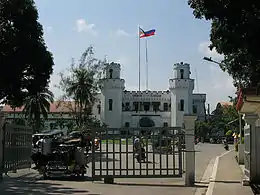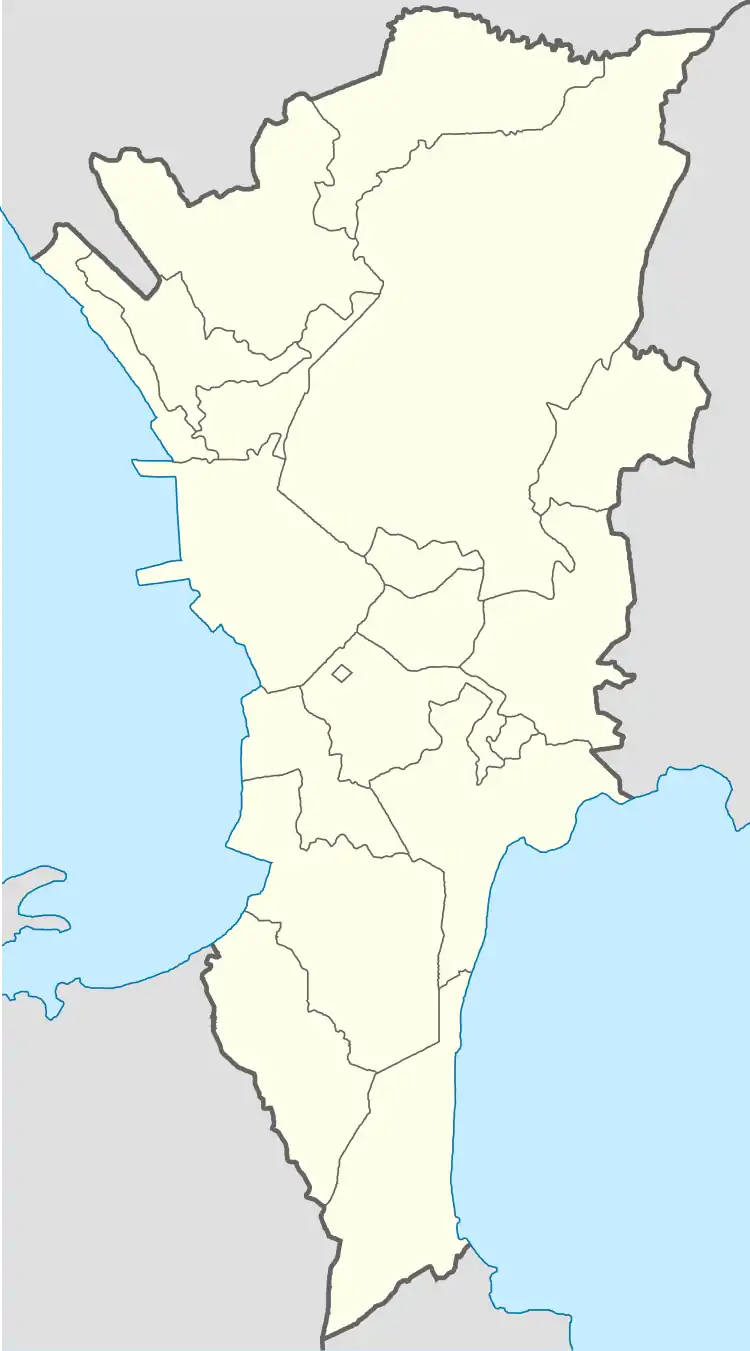New Bilibid Prison
The New Bilibid Prison (NBP) in Muntinlupa City, Philippines, is the main insular penitentiary designed to house the prison population of the Philippines.[1] It is maintained by the Bureau of Corrections (BuCor) under the Department of Justice. As of May 2018, the NBP housed 26,877 convicted criminals.[3]
  Façade of the current New Bilibid Prison. | |
 .svg.png.webp) .svg.png.webp) | |
| Location | Sampaguita Road, Muntinlupa, Philippines |
|---|---|
| Coordinates | 14°22′53.89″N 121°01′46.05″E |
| Status | Operational |
| Security class | Maximum security[1] |
| Capacity | 17,719[2] |
| Population | 36,295[2] (as of 2011[2]) |
| Opened | 1940 |
| Managed by | Philippine National Police Special Action Force Bureau of Corrections |
| City | Muntinlupa |
| Country | Philippines |
In 1940, prisoners were transferred to the NBP from the Old Bilibid Prison, also known as Carcel y Presidio Correccional[1] (Spanish, "Correctional Jail and Military Prison"), in the City of Manila. The remnants of the old facility was used by the City of Manila as its detention center, known today as Manila City Jail.
The penitentiary had an initial land area of 551 hectares (1,360 acres), but 104 hectares (260 acres) were transferred to a housing project of the Department of Justice.[4] Additional land of the NBP Reservation is used for the Bureau of Corrections headquarters.[5]
During Japanese occupation of the Philippines during World War II, Bilibid was a prisoner of war and civilian internee camp where American soldiers and civilians were held by the Japanese. Twelve hundred internees and POWs were freed by the American army on February 4, 1945, during the Battle of Manila.
The government of the Philippines plans to create a regional prison in Nueva Ecija through a public-private partnership.[6]
History

The Old Bilibid Prison, then known as Carcel y Presidio Correccional[1] (Spanish, "Correctional Jail and Military Prison") occupied a rectangular piece of land that was part of the Mayhalique Estate in the heart of Manila. The old prison was established by the Spanish colonial government on June 25, 1865 via royal decree.[4] It is divided into two sections: the Carcel, which could accommodate 600 inmates; and the Presidio, which could hold 527 prisoners.
Due to increasing crime, the Commonwealth of the Philippines enacted Commonwealth Act No. 67[1] and a new prison was built in Muntinlupa on 254.73hectares )[4] of land in an area considered at that time to be "remote". Muntinlupa sits quite a few miles southeast of the heart of Manila, on the shores of Laguna de Bay. Construction began on New Bilibid in 1936 with a budget of one million Philippine pesos.[1] In 1940, the prisoners, equipment and facilities were transferred from Old Bilibid to the new prison. The remnants of the old facility was used by the City of Manila as its detention center, known today as Manila City Jail. In 1941, the new facility was officially named the "New Bilibid Prison".
World War II internee camp
During World War II and the occupation of the Philippines by Japan, Old Bilibid and New Bilibid Prisons were used as Prisoner of War (POW) camps, hospitals for POWs, and transit centers for POWs being transferred to other locations, primarily to Japan. More than 13,000 POWs, the great majority of them American, were processed at these Manila area facilities during the war.[7] Included in that total are 500 civilian internees who were moved to Bilibid from the Camp Holmes Internment Camp near Baguio in December 1944.[8] Thousands of POWs who transited Bilibid Prison en route to Japan were killed when the Hell ships on which they were being transported were sunk by American military aircraft or submarines, the Americans being unaware that POWs were on board the ships.[9]
Old Bilibid prison continued to be used by the Japanese Kempeitai (military police) for holding special prisoners throughout their occupation of Manila and Luzon. General Vicente Lim was among those interned there.
The Battle of Manila began on February 3, 1945 and that evening the civilians in Old Bilibid Prison heard the unmistakable sound of American voices outside the walls. The American soldiers outside, however, seemed unaware of the prisoners inside Bilibid, but had the objective of liberating the 4,000 civilian internees at Santo Tomas Internment Camp two kilometers (one mile) away. The battle near the prison raged all that night, but the next morning the Japanese guards abandoned Bilibid leaving a message to the POWs and internees that they should avoid leaving Bilibid and posting a sign at the gate advising "Lawfully released Prisoners of War and internees are quartered here."[10]
The internees lofted an American flag over Bilibid, but after an explosion nearby the departing Japanese came back to warn them that the flag would draw fire from Japanese artillery.[11] At 7 p.m. on that evening, February 4, 1945, American soldiers from the 37th Ohio National Guard broke through the wall into the compound.[12]
The liberated POWs and internees at Old Bilibid numbered 1,200, including 700 soldiers and 500 civilians. The civilian internees remained in Bilibid for another month until the Battle of Manila concluded with the Japanese defenders wiped out.[13] The internees were then flown to Leyte and from there they were repatriated to the United States. One of the civilian internees described the repatriation process as "being badgered by friends rather than the enemy." The former internees were infuriated at having to promise to pay the U.S. government $275 per person for repatriation. Many of the civilian internees, long-term residents of the Philippines or related to Filipinos, were reluctant to leave, but were pressured to do so by the U.S. military.[14][15]
Post-War
From the end of World War II, until 1953, Japanese war criminals were held within the prison, under Prison Superintendent Alfredo Bunye.[16]
On June 5, 2014, Department of Justice Undersecretary Francisco Baraan III, supervising official on the Bureau of Corrections and the NBP said that the National Penitentiary will be moved to Barangay San Isidro in Laur, Nueva Ecija.[17][18]
Facilities

In 1999 Ron Gluckman of Asiaweek wrote that due to the commercial activity and relative freedom of movement in most of the prison, the facility "seems more like a barangay in the Philippines than a prison."[19]
Death penalty
The death chamber for inmates scheduled to die by electrocution was in Building 14, within the Maximum Security Compound of New Bilibid. As of 2015 it was used to house maximum security prisoners. The former lethal injection chamber is now used as the Bureau of Corrections (BuCor) Museum.[20]
In 1999 Gluckman wrote that the men's death row, in Building One, was uncharacteristic of the rest of the prison. He wrote "The place reeks of gas burners, sewage, sweat and fear."[19]
Recreational facilities
The prisoners pass the time in the basketball court in the penitentiary's gymnasium and are also engaged in the production of handicrafts. Various religious denominations are active in the prison, with masses said daily in the prison's Catholic chapel. These religious groups, such as the Seventh-day Adventist Church, Amazing Grace Christian ministries, Philippine Jesuit Prison Service and Caritas Manila, also extend medical services to prisoners.[21] Research participants agree that the use of inmate leaders is an integral component of prison management in the MSC. Inmates can either assume custodial, administrative, and rehabilitation functions.[22]
Educational facilities
Educational facilities inside the compound provide elementary education, high school education, vocational training and adult literacy programs. It also provides a Bachelor's Degree in Commerce.[21] The New Bilibid Prison also houses a talipapa (market) where the prisoners can buy commodities.[23]
Katarungan Village
On September 5, 1991, President Corazon C. Aquino issued Presidential Proclamation No. 792, which was amended by Presidential Proclamation No. 120 on December 15, 1992, to the effect that 104.22 hectares (257.5 acres) of land be developed into housing for employees of the Department of Justice and other government agencies. This housing project is known as the Katarungan ("Justice") Village.[24]
Notable inmates
- Amado V. Hernández is a National Artist of the Philippines for Literature who wrote his masterpieces while imprisoned in the facility.[25]
- Actor Robin Padilla converted to Islam and wed in an Islamic ceremony his first wife, Liezl Sicangco, whilst serving a 2-year prison sentence for illegal weapons possession.[26] He was released in 1998 after having been granted pardon by President Fidel Ramos.[27]
- Claire Phillips, an American spy who was awarded the Medal of Freedom in 1951
- Former Philippine senator Jovito Salonga was imprisoned by the Kempetai on April 1942, during the onset of the Japanese Occupation in World War II.[28]
- Claudio Teehankee, Jr., the son of former Chief Justice Claudio Teehankee, Sr., who was convicted of murder, homicide and attempted murder on October 6, 1995.[29] He was later released in 2008.
- Hubert Webb, the son of former senator Freddie Webb, was convicted on January 6, 2000 for his alleged role in the June 1991 Vizconde Massacre.[30] The Supreme Court later acquitted Webb on December 14, 2010.[31]
- Antonio Sanchez, former mayor of Calauan, Laguna, who was convicted of rape and homicide on March 14, 1995 for his alleged role in the June 1993 Murders of Eileen Sarmenta and Allan Gomez.
- General Tomoyuki Yamashita was the commander of the Japanese Imperial Army in the Philippines in 1944. He was incarcerated while undergoing trial for war crimes committed during the Japanese Occupation and was eventually executed by hanging in Los Baños, Laguna on February 23, 1946.[32]
- Luis Taruc, who pleaded guilty to a charge of rebellion in 1954 and was sentenced to 12 years imprisonment.[33]:143–144 He was later sentenced to four life terms for additional crimes.[33]:144–147 He was pardoned in 1968 by president Ferdinand Marcos.[34]
See also
References
- "Corrections in the Philippines". Archived from the original on April 11, 2008. Retrieved May 24, 2008.
- Tan, Kimberly Jane (August 29, 2012). "Drilon proposes selling New Bilibid, calls for regional prisons system". GMA News. Retrieved December 20, 2014.
- Talabong, Rambo. "IN NUMBERS: The inmates of New Bilibid Prison". Rappler.
- "IN NUMBERS: The inmates of New Bilibid Prison". Philippine Daily Inquirer. June 26, 2007. Retrieved May 25, 2008.
- "About the Bureau of Corrections Archived 2009-10-05 at the Wayback Machine." Bureau of Corrections. Retrieved on October 2, 2010. "Bureau of Corrections NBP Reservation Muntinlupa City, Philippines."
- Quismundo, Tarra (December 13, 2014). "New P50-B prison to rise in Nueva Ecija". newsinfo.inquirer.net. Retrieved May 25, 2016.
- "Notes" http://www.west-point-or/family/japanese-pow/HudsonFastNotes.htm%5B%5D, accessed April 27, 2016
- Mansell, Donald E. (2003), Under the Shadow of the Rising Sun, Nampa, ID: Pacific Press, pp. 216–217, 22–249
- Gladwin, Lee A. (2003), "American POWs on Japanese Ships Take a Voyage into Hell"; Prologue Magazine, Vo. 35, No. 4, https://www.archives.gov/publications/prologue/2003/winter/hell-ships-1.html, accessed April 28, 2016
- Crouter, Natalie (1980), Forbidden Diary: A Record of Wartime Internment, 1941–1945, New York: But Franklin & Co., pp. 467–470
- Miles, Fern Harrington (1987), Captive Community: Life in a Japanese Internment Camp, 1941–1945, Jefferson City, TN: Mossy Creek Press, pp. 162–163
- Mansell, pp. 247–254
- "Internment Camp #3, Baguio and Bilibid Prison" http://bacepow.net/bilibid.ht%5B%5D, accessed April 28, 2016
- Crouter, 502–503
- Hartendorp, A.V.H. The Japanese Occupation of the Philippines. Manila: Bookmark, 1967, pp. 613–626
- Calunsod, Ronron (April 30, 2015). "Philippine prison chief's humane treatment of Japanese POWs a lesson in forgiveness: son". Japan Times. Kyodo. Retrieved July 30, 2019.
- "DOJ to transfer Bilibid to Nueva Ecija". philstar.com.
- "Manila Standard – Google News Archive Search".
- Gluckman, Ron (July 23, 1999). "INSIDE STORY: CRIME AND PUNISHMENT". Asiaweek. Retrieved January 25, 2020. - Alternate link at Gluckman's website
- Torres-Tupas, Tetch (July 15, 2015). "DOJ drawing list of inmates to occupy death chamber-turned-prison". Philippine Daily Inquirer. Retrieved May 4, 2017.
- Liwag, Ramon J. "Community Involvement in the Rehabilitation and Treatment of Offenders" (PDF). United Nations Asia and Far East Institute for the Prevention of Crime and the Treatment of Offenders (UNAFEI). Archived from the original (PDF) on April 24, 2009. Retrieved May 25, 2008.
- Narag, R (2016). "Understanding Prison Management in the Philippines". The Prison Journal.
- Hicap, Jonathan M. (October 1, 2007). "New Bilibid to be like alien planet to Erap". The Manila Times. Archived from the original on December 11, 2007. Retrieved May 25, 2008.
- "Housing and Urban Development Coordinating Council". Retrieved May 26, 2008.
- Caruncho, Eric S. (November 18, 2007). "The blood of a poet". Philippine Daily Inquirer. Archived from the original on April 20, 2009. Retrieved May 25, 2008.
- Seno, Alexandra A. (1996). A Wedding Behind Bars Archived March 9, 2012, at the Wayback Machine. The Asiaweek Website, retrieved July 29, 2010
- Vanzi, Sol Jose (April 8, 1998) Robin Padilla Is Free. The Newsflash Website, retrieved July 29, 2010
- Pangalangan, Raul (August 3, 2007). "PASSION FOR REASON: Jovito Salonga as Magsaysay laureate". Philippine Daily Inquirer. Archived from the original on April 20, 2009. Retrieved May 25, 2008.
- "Claudio Teehankee Court Decision". Retrieved May 24, 2008.
- Hicap, Jonathan M. (January 17, 2005). "Hubert's main defense: 'I was in California'". The Manila Times. Archived from the original on April 2, 2008. Retrieved May 26, 2008.
- "SC acquits Hubert Webb, 6 others in Vizconde massacre". GMA News Online.
- Guy, George F. "The Defense of General Yamashita". Archived from the original on May 20, 2008. Retrieved May 25, 2008.
- Taruc, L., 1967, He Who Rides the Tiger, London: Geoffrey Chapman Ltd.
- Jay Taylor (1976). China and Southeast Asia: Peking's relations with revolutionary movements. Praeger. p. 322. ISBN 978-0-275-56830-6.
External links
- Images by Gerhard Joren at Getty Images
- "The lethal injection chamber at New Bilibid Prison." February 24, 2004.
- "The lethal injection chamber at New Bilibid Prison." February 24, 2004.
- "Superintendent Venancio Tesoro at the lethal injection chamber at New Bilibid Prison." February 27, 2004.